Many archers like to use a back quiver for roving or the 3-D range, but dislike them for hunting. Their reasons are numerous: My arrows rattle around and make noise. My heads get dull from banging together. When I bend over, my arrows fall out. Withdrawing an arrow flags game. My exposed arrows catch on every twig and branch. The area I hunt is too thick to go through the woods quietly. I am not flexible enough to remove my arrows without contortions. All of these issues can be resolved with a properly constructed, designed, and well broken in hunting quiver along with the time to become proficient and skilled in the use of the device. In fact, the back quiver can provide many advantages to the hunter.
The most noticeable advantage of the back quiver is removal of the quiver from the bow. Longbows especially are by design light in mass and delicate in the hand. A bow quiver adds weight, and it does so lopsidedly. The result is to ruin the balance that the bowyer intended. This imbalance can be a detriment to accurate shooting and the proper feel of the bow. If a bow quiver were more conducive to accuracy, Olympic archers would have them on their bows. In my opinion, the fewer things you have hanging off your bow for hunting purposes, the better off you will be.
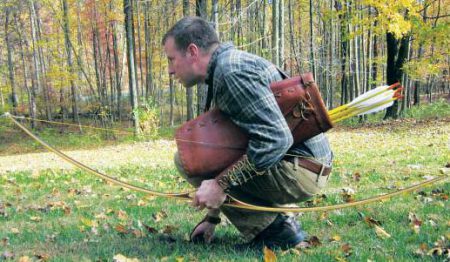
Rotate the quiver under your arm for going through thick brush.
Speed and capacity are two other advantages for which the back quiver gets the nod. Once an individual is proficient, a second arrow can be smoothly and fluidly back on the string and ready for action without looking or even consciously thinking about it. I have had more follow-up shots at game now that I exclusively use the back quiver. Some of those shots resulted in successfully downing game that would otherwise never have been recovered. I was never able to get that second arrow out and on the string as easily or as quickly as I do now with the back quiver.
To take the fullest advantage of this asset, the archer should nock from above a single nock point by sliding the arrow down the string from above. Trap the string between your thumb and forefinger, guide the string into the nock groove, and slide the nock down the string to your nocking point (nocking above). Angling the upper bow tip up slightly will assist in this “trap and slide” procedure. Next, guide the arrow to the rest and rotate your hand around the string until you are again in a position to shoot. With practice, this can all be done in a matter of a few seconds and without looking. This method, outlined by John Schulz in the video and booklet titled Hitting ’em Like Howard Hill, is the method with the most economy of motion and efficiency.
I also occasionally like to shoot at squirrels while deer hunting, and carrying more than a dozen mixed blunts and broadhead arrows is no problem for the back quiver. The quiver equipped with a single strap can also be easily rotated around the body and under the arm while going through thick brush. I like to switch my strap around so that the smooth finish side is next to the body in order to slide easier. When the cover does not require crawling or ducking, a skilled user will pass through the brush sideways to protect the protruding arrows with bow arm and foot forward. This automatically places the hunter in a better shooting position should game appear as he emerges with shoulders parallel and feet perpendicular. Besides, what other quiver can you put a squirrel, rabbit, and your lunch into?

Here are two quality products to break in and oil your quiver.
One of the most successful hunters in modern history was Howard Hill. He utilized and perfected a style of back quiver that now carries his name. The “Hill Style” quiver has many unique features that aid the hunter. This is the style and technique I will describe, as I feel it is superior to others.
The single thick strap allows sliding and rotation of the quiver around the body as I have described previously. The quiver is also equipped with a very wide body and oval mouth. This is not only to hold many arrows, but also to make withdrawing the arrow easier. Once the nock is secured, the arrow can almost immediately begin being withdrawn, steadily angled forward away from the quiver, thereby limiting movement and maximizing speed. If the tube were long and skinny, one would have to extract almost the entire length of the arrow shaft upwards before coming forward with it. An oval bottom also helps facilitate collapsing the leather to the back. As I will discuss, this is what holds the arrows and prevents them from banging together.
The quiver leather itself advances this end, with a medium-heavy thickness that gives weight and friction to the quiver when collapsed. Do yourself a favor and get a good Hill style quiver. There are several folks (including Howard Hill Archery) that still know how to build these beauties correctly. They are usually the same companies that sell Hill-style longbows. A stiff quiver that will not collapse or stay flexible, with large pockets, fancy embossing, and three chest straps, may seem really cool, but such equipment is putting your hunting at a disadvantage. Leather costs are high and these quivers are not cheap, but keep in mind that if you treat it well this one durable piece of equipment should last through a lifetime of hunting.

With a properly fitted and broken in quiver, six field tipped arrows stay securely inside even when inverted.
Once you obtain a quality quiver, it will need to be well broken in. The quiver should eventually conform to your back, the tube collapsing on itself. This holds the arrows still and secure. Several products can be used to help this conditioning. Montana Pitch Blend, mink oil, or even canola or olive oil will soften and condition the leather. During the summer, put the treated quiver out on your deck or atop your car and let it heat up really well in the sun. The leather will readily soak up the oil or treatment in this fashion. It is also a good idea to re-treat the quiver thoroughly once a year to help prevent dry rot and preserve the life of the leather. After treating, I will sit on it as I commute to and from work every day. Some folks put it under their couch cushions but I don’t spend much time on the couch.
Fold, bend, re-work, and re-treat until the quiver leather is pliable and readily collapses flat under its own weight around your back. The arrows should be lying in the quiver at an angle, not straight up and down. If the quiver is broken in and adjusted properly, you can bend over and almost completely invert the quiver without any arrows sliding out regardless of the points. The quiver should be adjusted so the strap is fairly snug, but able to be rotated freely when needed. The strap should go from your neck on the opening side to above the level of your nipple and under the arm of your bow hand. This places the arrows around the level of the top of your shoulder or just below.
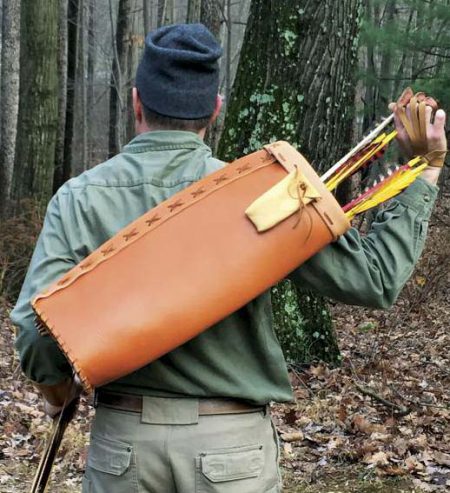
Elbow and hand bump methods for reaching nocks.
If you can touch the top of your shoulder, you should be flexible enough to get an arrow out. To make this easier, bump the bottom of the quiver with the elbow (or hand) of your bow arm to angle the quiver forward while at the same time reaching back with the drawing hand. Once you have the arrow nock you can pull the arrow around your body and the wide mouth of the quiver will help facilitate this movement.
When loading your arrows, do not just stuff them all down the opening at once in a jumble. Carefully place each arrow one atop the other, laying them in so that the shafts do not cross deep in the quiver bottom. This helps the shafts lie flat, sandwiched between the two layers of leather, and keeps the fletching from twisting together and making noise as you move. This way there does not need to be anything in the bottom of the quiver to keep arrows from rattling around. You do not need to embed them in foam or fill the bottom with oats, leaves, or anything else. Sheep shearling or padding around the opening is not necessary either. The quiver collapses and holds the arrows fast, preventing the broadhead edges from grinding together and your arrows from making noise. The only thing I put in the bottom of my quiver is a piece of scrap carpeting cut to match the bottom shape in order to dampen the thump of thick leather against the arrow when one drops in.
The final thing you need to do with your new quiver is use it! Knowing how to navigate through brush, knowing by feel where those arrows are in relation to that overhanging branch, not having to look back to draw smoothly and nock an arrow all take time and practice. The more you hunt with the back quiver, the more its redeeming qualities become apparent. Try it exclusively for at least a year of hunting before you discount it. Similar to the traditional bow itself, the back quiver takes some time and practice to get proficient with, but once you do it will pay dividends. Plus they just look classically cool. There was a reason the likes of Howard Hill, Ben Pearson, John Schulz, Bob Swinehart and numerous other bowhunting legends continued to utilize this type of quiver despite the wide availability of alternatives.


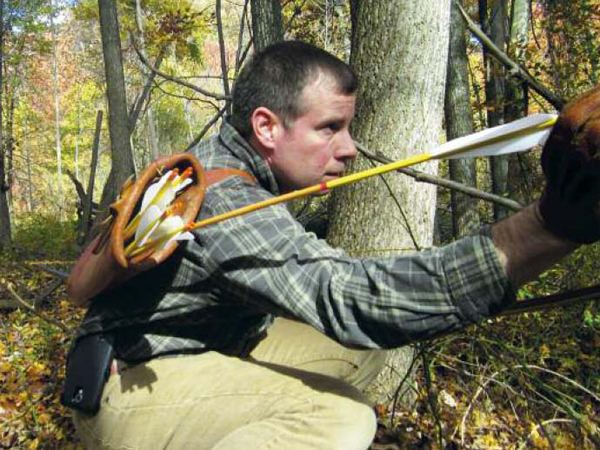
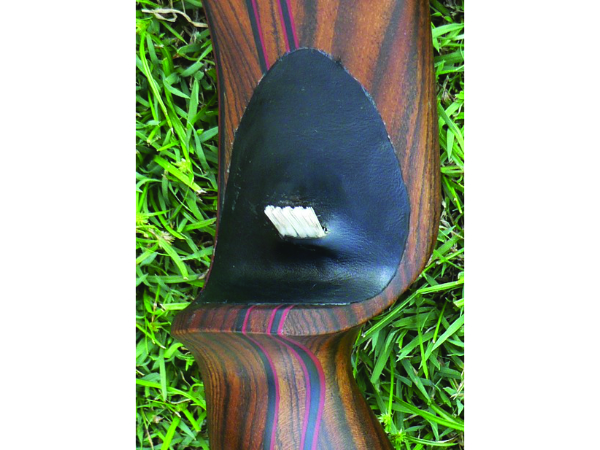
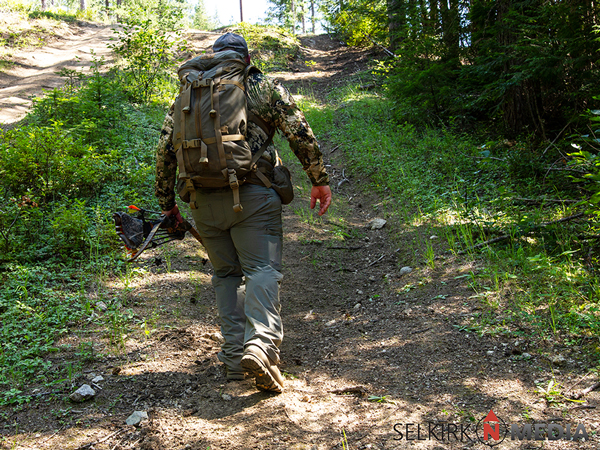


I have a great Hill Style quiver from Steve Catts. I use it all the time for non-hunting shooting now. I want to use it for hunting, but I struggle with extracting 3-blade broadheads. I don’t want to change my arrow formation and broadheads on account of a quiver. Any advice on 3-blade broadheads and back quivers. Oddly enough, it seems that everyone that writes about back quivers is more traditional than me and uses 2-blade broadheads, which I have and extract easily but I don’t prefer them over 3-blade for hunting.
Nick,
I have used 3 and 4 blade heads from my back quiver successfully. There is a greater chance of snagging another arrow when extracting, but this can be offset with a wide quiver and only keeping up to 5 BH arrows in it. Don’t overload it. Also, make sure when you load the quiver you do so carefully and place one arrow atop the other in a stack. This will help keep them from twisting together and becoming interlocked. @ blades do lessen the issues but these small challenges are not deal breakers to me at least.
I’ve hunted with a back quiver for years, I went to a seminar by John Shultz and was hooked. I do like to nock my arrow under the nocking point, and have no trouble placing my arrow on the string and sliding it up.
I’m a back quiver hunter, I hunt with a longbow. My issue is trying to keep my feathers dry.
After reading this two years ago I have made such a quiver.
I order to have ease of drawing the arrows, I had to experiment with the hight a bit. I reduced the quiver hight ca. two inches from what I first made.
At first I used a strap of the same material es the quiver. I replaced this with thicker belt leather. The strap holes on the quiver showed some wear, Remedy for this was reinforcing them with a patch on belt leather on the inside.
To protect the bottom of the quiver, I put a patch of 1/4 inch rubber mating inside. (Type you use to dampen washing machines) A piece of carped would do the same.
Once I found this article,I re-read it all the time to keep my ideas of trying other type of quivers in check! I bought my Hill style quiver back when James Schulz owned American Leathers,and it was with me when I shot my 1st whitetail from the ground stillhunting so it’s earned its place!!! Thank you writing this Greg!